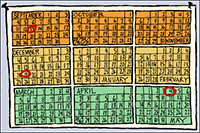What are some factors that should be addressed when implementing the RTI approach?
Page 14: Scheduling Considerations

 Scheduling is often overlooked, but it is important for the successful implementation of the RTI approach. As Mr. Irwin, Ms. Hooper, and the planning team start to think about the adjustments they need to make to accommodate those involved in the RTI process, they realize they need to schedule several activities:
Scheduling is often overlooked, but it is important for the successful implementation of the RTI approach. As Mr. Irwin, Ms. Hooper, and the planning team start to think about the adjustments they need to make to accommodate those involved in the RTI process, they realize they need to schedule several activities:
- 90 minutes of uninterrupted core-reading time in the general education classroom
- Tier 2 and Tier 3 intervention time coordinated between teachers and intervention providers
- Release time for teachers to plan instruction, to collaborate with other teachers, to discuss student data, and to meet with a coach or mentor
Listen as Thea Woodruff provides a good model of how one school schedules instructional and intervention time and how this collaborative effort promotes teacher support for RTI (time: 1:09).

Thea Woodruff, PhD
Director, Professional Development and Technical Assistance Teams,
Vaughn Gross Center’s Reading First Project
University of Texas, Austin
Transcript: Thea Woodruff, PhD
I can give you an example of a principal who really does a good job with scheduling. She basically has all of the grade levels come to the cafeteria for half a day, or a full day, depending on how long it’s going to take. And she has all of the interventionists—so the speech therapist, the special ed teachers, interventionists for tier 2 and tier 3, their paraprofessionals—everyone comes to the cafeteria, and every grade level has a cafeteria table with butcher paper on it. They grid it off so they can create their schedules, and they all stay in that cafeteria and create their schedules, and the assistant principals, the reading coach, and the principal walk around and facilitate. What it does is it gets the teachers to buy in because they’re actually the ones creating the schedule, but they’re also getting the support from all these other people who are walking around and helping them analyze what’s happening and where kids can fit in. And they walk around with sticky notes, basically, and put kids’ names in places and when they’re going to get pulled. And the grade levels work together to schedule their time. And so the grade levels come together, and they decide when their reading block’s going to be, and it provides a lot of collaboration. They get really motivated to figure these things out because they bought into it.